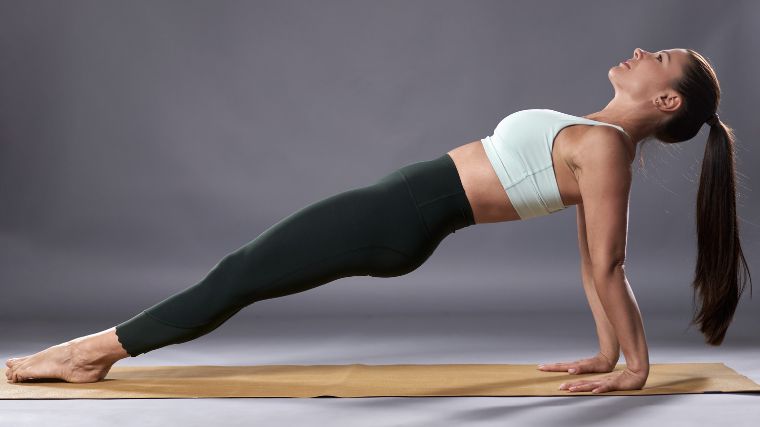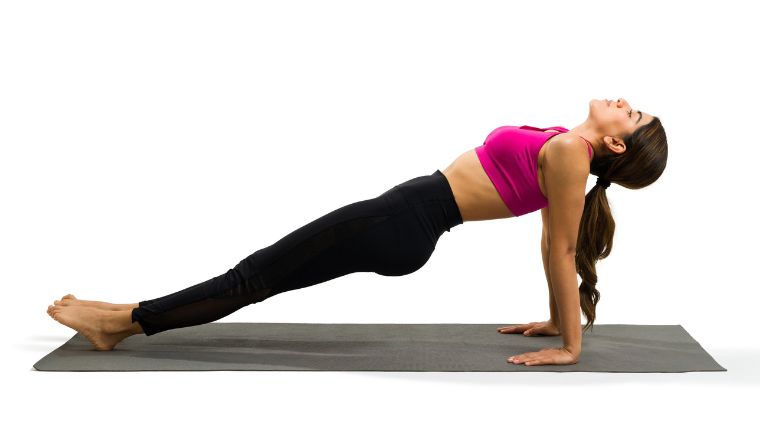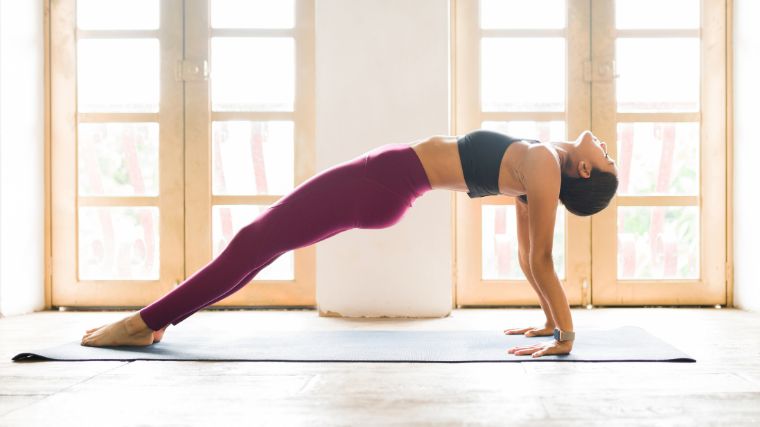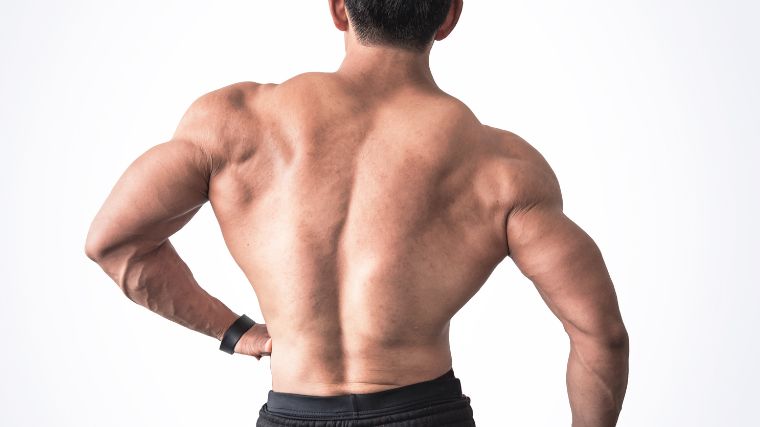The garden-variety plank is one of those exercises that many people begin or end their workouts with. It’s simple, reliable, and accessible: Even people who don’t engage in regular planking still technically know how to the plank — the posture is almost identical to the push-up, after all.
If you’re on the prowl for a simple adjustment to the plank that’ll pull in a big payday, you’re in luck. The reverse plank will address your entire backside, from your lower back to your glutes, hamstrings, and more.

If you want to involve these muscles in your training and build your endurance without firing off reps every other second, you can simply flip your body over and assume the position of a reverse plank. All of your posterior muscles will be strengthened by the simple act of preventing your torso from falling to the floor.
- How to Do the Reverse Plank
- Reverse Plank Sets and Reps
- Common Reverse Plank Mistakes
- Reverse Plank Variations
- Reverse Plank Alternatives
- Muscles Worked by the Reverse Plank
- Benefits of the Reverse Plank
- Who Should Do the Reverse Plank
- Frequently Asked Questions
How to Do the Reverse Plank
In order to do some reverse planks, all you need to do is maintain your spine and legs in a straight line while you use your arms to prop yourself off the ground. It isn’t nearly as easy as it sounds, but you’ll discover that for yourself by completing the following steps.
Step 1 — Set Yourself Up

Sit down on the floor in an upright position, with your legs extended straight out in front of you. Reach behind your torso with your arms and plant your palms flat on the floor, elbows straight.
Coach’s Tip: If you have discomfort in your shoulders or want to add to the mobility of your chest, you can try the reverse plank with your hands rotated outward and your fingers facing away from your body.
Step 2 — Bridge Your Body

Lean back, pull your shoulders backwards, and squeeze your glutes to extend your hips. Your behind should come off the floor. There should be a straight line from your shoulders to your ankles.
Coach’s Tip: To help yourself get into a properly bridged position, you should keep your head neutral, or even lift it backwards to permit your body to fully open up.
Reverse Plank Sets and Reps
Much like the basic, face-down plank, the reverse plank is typically performed either as a warm-up prior to your major pulling movements, or at the conclusion of your back workout. Most of your programming options will revolve around your competence level with the exercise:
- Beginner: Four sets of 15 to 30 seconds.
- Intermediate: Four sets of 45 seconds to one minute.
- Advanced: Two to three sets of 90 seconds to two minutes.
Common Reverse Plank Mistakes
Seeing a photo of someone in a reverse plank position makes the exercise look deceptively simple; it isn’t necessarily easy. Not only are you going to be challenged to sustain the position, but if your muscles tend to be stiff, you may feel like you’re having to uncomfortably contort your body just to begin. Here are some common mistakes that you might be lured into.
Poor Hand Position
This is one of those exercises where the most beneficial hand positioning is subjective. The textbook hand position is with your fingers facing toward your body, but for some people, changing the direction of the hands can help open up the shoulders and chest.
This can make it easier to elevate your torso into its optimal position. Avoid jamming your wrists into a position that isn’t comfortable or sustainable.
Hunching Your Back
One of the most common mistakes made during reverse planks is to allow your shoulders to dip forward. This error can have several root causes, including an insistence on lowering your chin and looking toward your feet, or simply not extending your hands back far enough. Ensure that your shoulders stay packed down and retracted for your entire set.
Arching Your Back
While it’s a less common problem than hunching your back, pressing into the ground through your feet and palms too aggressively can cause you to excessively extend your spine.

[Read More: 5 At-Home Workouts for Strength, Muscle Growth, Power, and More]
Extending your body beyond the desired alignment of the reverse plank defeats the purpose of this particular exercise — the goal is to maintain tight, neutral alignment between your ribcage and your pelvis.
Reverse Plank Variations
There are several versions of the reverse plank that you can complete; all of them fulfill the reverse plank’s essential requirement of compelling you to compete with gravity to hold your body aloft. These exercises are listed in order from the least challenging to the most difficult.
Reverse Plank Bridge
By keeping your feet flat on the ground and bending at your knees, you will alleviate measurable pressure from your glutes and hamstrings while you still maintain the alignment of your spine and hips.
The reverse plank bridge shortens the moment arm of the exercise; straight knees will elongate your body, imparting greater force onto your joints as a result. This isn’t harmful, but if you’re new to bodyweight exercise, you may want to start with the bridge instead.
Reverse Plank on Elbows
For another variation of the reverse plank that reduces the stress on your shoulders, you can do reverse planks with both of your forearms on the ground.
Bench Reverse Plank
A proper plank places your torso parallel, or almost parallel, to the floor. This posture evenly distributes the downward force of gravity across all of the relevant joints. However, the nature of the reverse plank itself makes it difficult to accomplish this goal without adding some extra equipment into the mix.
https://www.youtube.com/watch?v=MhZOz4Qwa64
You can fix this by working with two elevated surfaces, like a bench or a pair of plyometric boxes. Sit between them, with your feet up on one and your shoulders back against the other. Squeeze your glutes to lift yourself up off the floor and suspend your body parallel to the ground.
Reverse Plank Alternatives
If you’re not sure if the reverse plank is the exercise you’re looking for, but you still think your posterior chain can use some work, here are a few exercise options that will leave your hamstrings, glutes and spinal erectors burnt to a crisp.
Glute Bridge
This popular glute exercise won’t provide as much tension along your back, but it does require engagement of the glutes to initiate and sustain the bridging function. The bridge teaches you to train your hip extensors dynamically, rather than holding them motionless in place.
You can also load the bridge with almost any type of resistance. A barbell works well for maximal mechanical tension, but you can also work with a pair of dumbbells or a heavy kettlebell.
Hip Thrust
The standard hip thrust closely replicates the posture and challenges presented by the reverse plank. By supporting your torso against a bench or box and then extending your hips, you train all of the same musculature as the reverse plank.
[Read More: The 8 Best Knee Sleeves You Can Buy (Spring 2023 Update)]
Hip thrusts are phenomenal for muscle growth in your glutes in particular. Bent knees will take your hamstrings out of the limelight to a degree, as there will be some slack in the tissue. However, you pick up an unparalleled amount of stimulus to your glutes. That’s the trade-off.
Glute-Ham Raise
If you have access to the machine, the glute-ham raise is indispensable for your posterior chain. While this is a face-down movement, it requires engagement of the glutes, hamstrings, and spinal erectors in order to repeatedly elevate your body and keep it rigid against gravity.
You can ante up on the challenge by holding a light weight to your torso, but be warned: The glute-ham raise is more than challenging enough for most folks without any extra weight at all.
Muscles Worked by the Reverse Plank
Saying that the reverse plank involves the bulk of your rearward-facing muscles is no exaggeration. Your legs, glutes, back and shoulders are all going to perform some serious work to keep you from collapsing back to the ground.
Glutes
Your gluteal muscles (that’s your gluteus maximus, medius, and minimus) are among the largest and strongest tissues in your lower half. They’re mostly responsible for controlling your hips and stabilizing your pelvis.
During the reverse plank, your glutes engage and clench specifically to elevate your backside off the ground. Since your glutes fall directly in the middle of your two anchor points (your palms and feet), they’ll bear the most overall load as you strive to maintain a straightened body.
Hamstrings
Your hamstrings work in concert with your glutes to maintain your body’s elevated position during the reverse plank. The hamstrings are a biarticular muscle; they cross both your hip and knee joints.
As such, your hamstrings are partially responsible for extending your hips and straightening your knees. Your hamstrings provide an assistive role in maintaining tension across your kinetic chain during an isometric exercise like the reverse plank.
Erector Spinae
If you perform the reverse plank properly, you shouldn’t feel too much stress in your lower back. The primary duty of your lumbar erectors is to extend your spine. However, a good reverse plank should contain a neutral spine, limiting the role of your erectors in the first place.

If you notice that your lower back lights up after just a few seconds of reverse planking, you may be utilizing incorrect form, straightening your body by arching your back rather than extending your hips.
Benefits of the Reverse Plank
Just as it might be tough to believe that an exercise that looks so simple could be so difficult, it may also surprise you just how beneficial it can be to simply hold your body in place for several seconds at a time. Well, seeing is believing, and after a few weeks of reverse planks you’ll be made gladly aware of all of these benefits to your body.
Improved Posture
Everyday activities like desk sitting, couch slouching, and a general bias toward training your forward-facing body parts can sometimes result in a sloped posture. Reverse planks require all of your rearward body parts to press against gravity, a stimulus you don’t get often from day-to-day activities.
A few sets of reverse planks scattered throughout your day may encourage you to maintain better posture from sunrise to sunset.
Builds Durability
As demanding as the reverse plank can be, it is simultaneously one of the safest endurance exercises for all of the muscles within the back half of your body. If you are training for physical sustainability, let alone mental toughness, enduring the reverse plank will transform you into someone who can endure punishment.
Improved Chest and Shoulder Flexibility
As a secondary benefit, the 90-degree angles at which your shoulders engage with the floor is sufficient to replicate or even exceed that of most variations of the standard arms-backward chest stretch. So while your back and glute muscles are being strengthened, the muscles that connect at your shoulder girdle will enjoy a tremendous stretch.
Who Should Do the Reverse Plank
Whether your most physically taxing days ahead of you, presently underway, or long behind you, the reverse plank can improve the state of your body to help you thrive in whatever stage of life you presently find yourself in.
Aging Lifters
Beyond a certain age, it can become difficult (or in some cases, dangerous) to persist with certain forms of training. This can certainly include explosive forms of exercise, like both ballistic training and plyometrics. Isometric exercises like the reverse plank enable trainees to exercise their muscles while limiting their ranges of motion or imparting ballistic force onto sensitive joints.
Racing Athletes
To racing athletes like cross-country runners, skiers, speed skaters and swimmers, maintaining an optimal body position is critical.

[Read More: The 9 Best Ashwagandha Supplements (2023 Update)]
Preparing your core muscles to sustain a proper body posture while your limbs are propelling you forward is an essential skill, and a requirement for success in these types of activities.
If You Need a Posture Reminder
Slumping into our couches and slouching over our work desks has wreaked havoc on our collective spines, causing our shoulders, necks and heads to drift forward. The reverse plank forces you to activate your spinal erectors to shift your spine back into its proper configuration.
Serious Strength Athletes
For Olympic lifters and powerlifters, a posterior chain capable of holding up under stress is absolutely essential in order to tolerate exceedingly heavy weights. Because isometric training helps muscles to gain strength in a fixed position, reverse planks supplement critical postures during heavy lifting. Think a deadlift lockout, a good bench press set-up, or the starting position for the overhead press.
Go Forward in Reverse
No matter what your favorite activity is, you’ll enjoy it more if you have robust, functional back strength. The reverse plank is simple, accessible, and enjoyable (if you like testing your pain tolerance, that is). Throw it into your next core workout and begin reaping the benefits.
FAQs
Still have some questions about the reverse plank? We don’t blame you! Here are some answers.
Can reverse planks fully replace regular planks in my training program?
Despite the similar goals of keeping the body aligned, planks and reverse planks activate very different muscles. In both cases, all of the stabilizing force is directed downward, so the muscles facing the ground are always doing the bulk of the work.
If you desire to train both your anterior and posterior muscles isometrically, you would be advised to include both planks and reverse planks in your training plan.
If I do reverse planks, do I still need to train my back and glutes separately?
It depends on your goals, but it is often advised that you challenge your muscles by forcing them to work against resistance throughout their full range of motion. Because reverse planks are an isometric exercise, they only enable your activated muscles to gain strength in a single position.
Can I rely solely on stability exercises like the reverse plank, or should I do other types of exercises?
It depends on what your goals are. Isometric exercises are excellent for engaging muscles that might otherwise go unaddressed or be underutilized, and there are some advantages. However, they tend to underperform in comparison to exercises that require a muscle to go through full flexion and extension, at least with respect to total muscle activation.
For the sake of being thorough, it might be best to complement your reverse plank training with other exercises addressing the same muscle groups, like back extensions or stiff-legged deadlifts.
Featured Image: Slatan / Shutterstock